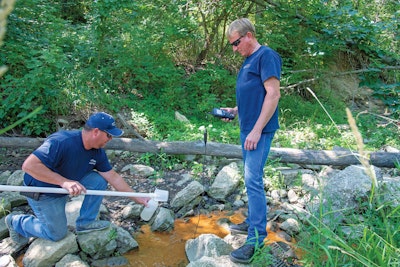
Detail view of the Hach HP30D dissolved oxygen meter used by Kirksville Public Works employee Tim Reed.
Interested in Stormwater?
Get Stormwater articles, news and videos right in your inbox! Sign up now.
Stormwater + Get AlertsPossibly the only thing worse than a failed stormwater system is a failed plan to fix it. This is what Glenn Balliew discovered in June 2017.
While still a relatively new director of public works in Kirksville, Missouri, Balliew was confronted with a chronic stormwater problem that turned critical. “We received a report from the Department of Natural Resources that said we were not doing enough to fulfill the requirements of the stormwater management program we had, that we weren’t complying with our own management program,” he says. “And we weren’t.”
Kirksville is a community of nearly 20,000 people in northeast Missouri. Sitting just below Iowa, it experiences the verdant region’s usually ample rainfall, with nearly 40 inches falling each year. Below its fertile soil is a pan of clay that resists quick absorption, so water tends to run across the ground instead of disappearing into it. The city’s flood potential is worsened by the lay of the land, which a West Virginian would call flat. In fact, the city’s general topography is one of gentle swales and inclines.
The 2017 DNR report came after a review of the document officially guiding the city’s stormwater program. The management plan had been formulated in 2011 by an engineering firm with offices up and down the Midwest from Texas to South Dakota. Voters had approved a $2.2-million bond referendum the year before to fund stormwater improvements, with revenue to be collected through monthly utility bills.
Practical changes
In 2013, the city cosmetically updated its management plan. Yet it remained a document mostly honored in the breach, a situation DNR inspectors finally flagged in 2017 and Balliew set about to correct. He began by critically reading it. He wasn’t impressed. “It was easy to see it was a difficult plan to comply with,” he says. “It was very specific, and things never were really approved right. It just wasn’t going to work.”
His response was to gather his entire staff, including the city’s code director who is in charge of inspections. Balliew told them to think fresh about what a stormwater management plan should look like. “I asked them to tell me what they could and couldn’t do and what worked and didn’t work. And then we went through the plan and wrote a new one ourselves. We didn’t need an outside contractor. It wasn’t that complicated.”
Balliew encourages other municipalities to take similar initiative in setting up management systems. “I want to say out loud, ‘You don’t have to pay someone to do the work. It’s not difficult. You write it to work for you, instead of paying someone to tell you what he or she thinks you need. Don’t be intimidated to sit down with a management plan and make it work for you.’”
It is pertinent to note that the DNR approved of the department’s rewrite. “The DNR liked it. We took a big, thick document and reduced it down to 14 pages and some maps.”
One of the practical changes made in the document was to address topics more generically. Specifics can hamstring a person or a department tasked with compliance. For example: Under the section entitled “Public Involvement/Participation,” the 2011 plan said the city would work with the local 4-H Club to educate club members about proper disposal of hazardous waste and grass clippings. “In addition, the goal is to ask the 4-H Club along with citizen volunteers to participate in a stream cleanup once a year.”
During the intervening six years, either no one got around to asking the 4-H Club for help, or club members declined to assist. “So when the 4-H Club didn’t do it, the city was not in compliance,” Balliew says. “We changed it to read that anyone can help — that the cleanup would be done by someone.” Simple as that. The rewrite gave his department practical working room to comply with oversight regulations.
It didn’t help that oversight of the city’s wastewater plant fell short of operational standards. With a new plant manager in place and a more practical document approved, Kirksville moved ahead with a six-pronged response to its stormwater runoff challenges, which included pollution from illicit or accidental discharges.
Taking action
Public education and awareness initiatives are key to the program’s success. This was not a new approach. The supplanted program also preached public outreach and involvement, but Balliew’s plan emphasizes action. He summarizes it as, “If you see something, say something.” In other words, if a community resident sees a bunch of dead weeds in a ditch or pooled water in a dry season, he should recognize it as an anomaly and tell a public official. “We need to know about it.”
People have responded. Balliew cites the example of a local business that uses salt in its everyday activity and dumped excess salt in its dumpster. At that point, the problem was contained. However, the dumpster leaked. The salt spilled out and entered a nearby storm drain from where it eventually migrated to a ditch and killed grasses and weeds. A citizen noticed the dead patch in the ditch and notified City Hall. “That wouldn’t have happened if we had not educated them,” Balliew says.
The rest of the story was how the department responded to the citizen’s tip. “We did testing on the salt in the ditch and we knew right away it was an organic problem, not a chemical one.” From there, the city tracked the salt to its source. In another incident, the culprit was a sump pump in a basement that discharged into a city gutter. After the basement flooded, tipping an old home oil tank and spilling its contents into the city system via the sump pump, Balliew’s staff backtracked the oil and found the source. “It just took a few days,” he recalls.
Educational efforts continue in various forms: brochures, requests on the city website for citizen service, a monthly newsletter, periodic stormwater alert reminders in water bills, and news releases to local media. “Two years ago, there was no way for a citizen to let us know about a problem unless they called us, and they didn’t now what to look for. We made it easy. It is an all-of-the-above approach to getting out the word.”
Public participation has increased as awareness has grown. Balliew says “a lot of people” are volunteering to help clean up streams, stencil identifying information on stormwater inlets, bring in materials on hazardous waste disposal days, and sponsor adopt-a-street initiatives. “The more that people bring in toxic stuff and pick up debris in their cleaning of ditches, the less of it there is in our stormwater system.”
Managing growth
Kirksville is booming economically, which Balliew describes as the largest growth spurt in 30 years. A Kraft Heinz food plant announced a $250 million expansion in 2017, including the addition of 200 jobs. This year, the Menards home improvement store chain opened its largest U.S. outlet in Kirksville. Also new to the town are Hobby Lobby and Petco stores, a new retirement center, and new hotels and housing.
All of which means city inspectors have additional responsibility to control construction site runoff into the municipal stormwater system. Growth is a welcome challenge, but a challenge nonetheless. Post-construction runoff also is monitored. “If grass doesn’t get planted at job sites and contractors pull up their erosion fences too early, runoff can be a problem,” Balliew says. “After a certain amount of time if things don’t improve, they are required to come back and redo it. It’s all part of the inspection process.”
Kirksville was laid out in 1841. Six major watersheds with numerous tributary drainage basins run through the city. Authorities don’t even know how many miles of stormwater main and feeder lines are in the ground.
“We encounter storm drainage infrastructure that is not mapped or recorded. It can be a challenge. We have storm system pipe from 6 inches in diameter to 72 inches, with several pipes and culverts at the end of their life cycle.”
With citizen approval, Kirksville reallocated revenue from an economic development sales tax to fund infrastructure work and added an extra $300,000 for stormwater projects. Work will begin in 2019. In addition, the Missouri Department of Transportation has penciled into its budget the replacement of small stormwater inlets with undersized drain-off pipes. The state’s participation is only fair since, according to Balliew, “the majority of street flooding happens on roads managed by the Department of Transportation.”
Equal importance
The city’s Public Works department isn’t just about stormwater, of course. The city has a newly expanded wastewater treatment plant, and next year, Kirksville is erecting a million-gallon water tower downtown to replace a 64-year-old tower, the oldest of four existing elevated water structures. The new tower is more than twice the size of the old one and will bring total storage capacity to 4.5 million gallons. The expansion of towered water is part of a strategy to keep ahead of economic development.
The city water department reads about 7,000 meters a month, but water users far exceed that number because the city also meters and supplies water to Adair County water districts. The total water customer base is more than 25,000 people. To help keep the waterlines intact, the city handles all water main breaks with its own maintenance crew. So far in 2018, 32 waterline failures have been repaired. Larger jobs are contracted out. “Our goal is to install 10,000 feet of water main annually, in-house, until all ductal iron pipe is replaced,” Balliew says.
In this mix of responsibilities, the public works director gives as much weight to stormwater needs as he does to water and wastewater issues. “Stormwater is a utility,” he says, “It is not much different than streets or the water system. It has to be treated the same as them. When we have stormwater issues and pollution issues, we have to treat it with the same urgency we treat street issues.”
The leader, the team
The team responsible for managing the Kirksville, Missouri, stormwater system was energized with the 2016 arrival of Glenn Balliew.
While not specifically trained for the administrative position, the Public Works director brought to the office confidence and leadership-ability born of decades of management positions in federal and military aviation. The list of air control positions is long, but include stints in Iraq, Afghanistan, Korea and South America. As a Federal Aviation Administration employee, he helped regulate national air space after the 9/11 terrorist attacks and for seven years helped coordinate movement of Air Force One.
He made the leap to Kirksville in 2013 when his wife, Molly, expressed a desire to return home to Missouri. He became director of the Kirksville Regional Airport, subsequently filled in at City Hall as interim public works director when a vacancy occurred there, and three years ago took over the department. It was a friendly takeover.
“I challenge them, and they challenge me,” he says of his department staff. “All the supervisors are proven leaders. We are fortunate to have or to have found a management staff with extensive experience and institutional knowledge of all systems and operations. We have some young employees, too. The next generation of leadership is just around the corner.”
He talks about instilling confidence in his department colleagues and giving them freedom to develop. “I get them what they need, turn them loose, and offer advice or provide guidance if needed. Approve the plan, turn them loose, and you will be amazed at what they can accomplish. As I like to say, ‘You can either be the show or watch the show. Go be the show.’”
Truman State University is part of the show. The 6,000-student liberal arts and sciences campus contributes to the city’s water-quality efforts. “They are a big ally,” Balliew says of the local institution. “They are great to work with. They have lab staff who help us, and they have volunteered to assist with spring cleanup.”
He probably also can count as members of his team the many city residents who have responded to the department’s appeal for help. Balliew and staff constantly ask the community for stormwater system alerts and to partner with the city in policing stormwater, wastewater and water systems. By and large, citizens have come forward.
“I tell you, the whole water thing in Flint, Michigan, that was a big issue. That exposed a lot of things in the entire U.S.,” he says. “Most people who understand the issues appreciate the information we give them and are willing to get involved. When we talk about how clean our water is, they are all in, with a couple of naysayers here and there. We are not a big monster city, but we’re not a little town either. We can supply good water quality for ourselves, and people want to help us continue to do so.”








